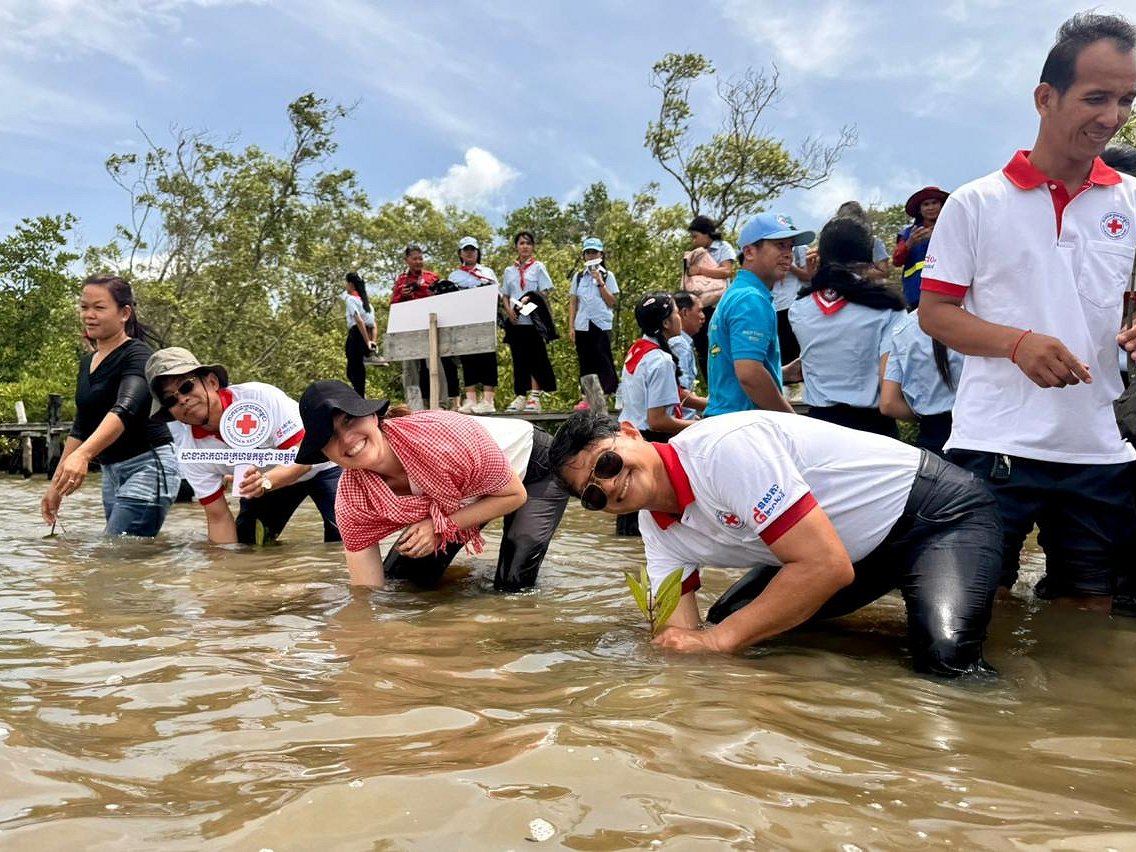
Rooted in resilience: Cambodian Red Cross unites communities to restore mangroves

By Kwanta Norkum, IFRC Communications and Reporting Officer
(This story appeared first yesterday on the IFRC website, where you can read more about Red Cross Red Crescent climate-smart disaster risk reduction and resilience.)
On World Mangrove Day tomorrow 26 July, we celebrate nature’s humble heroes – the remarkable coastal forests that filter water, protect coastlines from storm surges and erosion, and store up to four times more carbon than tropical rainforests.
In southern Cambodia’s Kampot province, a recent mangrove planting event brought together Red Cross volunteers and local residents – young and old – along with the IFRC to restore degraded coastal areas by planting mangrove trees.
“What’s special about today is seeing people from all walks of life coming together,” says 76-year-old Cambodian Red Cross (CRC) volunteer Norm Teat.
“Planting mangroves isn’t just about trees – it’s about protecting our future,” he adds. “These trees help prevent coastal erosion, support marine life, and even absorb harmful carbon from the atmosphere.”
Recognizing also the vital importance of coastal mangrove forests in protecting shorelines during severe storms, the CRC is working partnership with the IFRC, local communities and other stakeholders to plant mangroves and promote long-term environmental stewardship.
These community-based efforts are part of a wider campaign to raise awareness and increase resilience to climate-related disasters such as coastal flooding and storms.
‘Planting mangroves isn’t just about trees –
it’s about protecting our future’
“In Kampot province, there are more than 800 Red Cross volunteers and more than 1,000 Red Cross youth,” said Men Neary Sopheak, First Deputy Secretary General of the Cambodian Red Cross.
“The Red Cross’s mangrove initiative is a part of our broader commitment to healthy and climate-resilient communities in Cambodia. By restoring and conserving mangrove forests, we help protect biodiversity, improve water quality, and support the livelihoods of people living along the coast.”
Why are mangrove forests so resilient in the fact of severe weather? One reason is that some mangrove trees can “breathe” through aerial roots that rise above the muddy ground like snorkels. This allows them to survive in waterlogged soils.
The CRC’s approach extends beyond planting. Through community training in mangrove care, disaster preparedness, and environmental protection, the Red Cross is empowering local people to become stewards of their own environment.
“The climate is changing, and we must support communities to adapt – especially for the sake of future generations,” said Kathryn Clarkson, IFRC Head of Delegation for Thailand, Cambodia, the Lao People’s Democratic Republic, and Viet Nam.
“I’ve joined mangrove planting activities with the Cambodian Red Cross many times, and each time it reinforces how vital mangroves are, not only as a natural defence system but also as an absorber of carbon from the atmosphere and as a symbol of resilience.”
For 76-year-old Mr. Norm Teat, the campaign holds deep personal meaning. “I’ve been a Cambodian Red Cross volunteer since 2014,” he says. “Over the years, I’ve learned so much – about health, disaster preparedness, vegetable farming, and protecting our environment – and I share this knowledge with my family and community”.
As mangroves face growing threats from development and climate change, initiatives like these demonstrate the strength of community-led action.
In recognition of World Mangrove Day, we celebrate the communities working to protect these unique ecosystems for a greener, safer and more resilient future.
Along with members of a local community in Kampot province, volunteers and other representatives from the Cambodian Red Cross and the IFRC stand knee-deep in coastal waters as they reach down and plant mangrove trees into the muddy sea bed. (Photo: CRC)